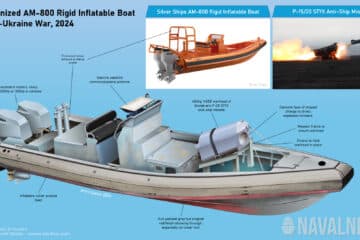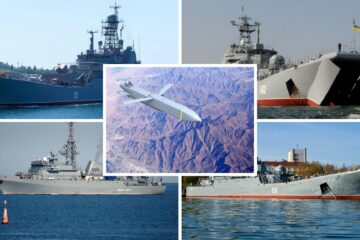In late February two Russian government ships did something highly unusual. The transport ship Sparta-IV and tanker Yaz were sailing from the Russian base at Tartus in Syria towards the Black Sea. These ships are generally used to transport military assets. Sparta-IV has previously been used to ship S-300 missile systems from Syria to Russia, and Yaz is the sister ship of Sig which was hit by Ukrainian maritime drones on August 5 2023.
But this time, as the ships approached the Bosporus, the Strait which connects the Mediterrean to the Black Sea, they abruptly turned around. This is another strong indicator that Ukraine’s maritime drones are having a strategic impact.
Ukraine’s maritime drones, properly terms uncrewed surface vessels (USVs) have become a defining symbol in the war. They capture headlines when they sink Russian warships, such as the Sergey Kotov which was attacked on March 4. But their prescience has had a much larger, yet subtle, impact on the war. The Russian Navy is placed under threat and has to act accordingly.
It is no longer in control of the Black Sea like it was at the start of the 2022 invasion. Its Black Sea supply lines, relying on ships like Sparta-IV, have had to be escorted. Now they are avoiding the route altogether, adding weeks to the supply lines.
A Brush With The Threat
A new detail sheds more light on the threat. On March 4, hours before the Sergey Kotov was hit near Kerch, the Russian ship ‘Ella’ had an encounter with four drones. These are likely the same ones which then sunk the warship.
According to a Captain’s Report shared online, which we judge to be credible, Ella reported sighting 4 maritime drones at 2.15pm local time. The ship was at a position 43°10.1 N 033°55.7 E in the middle of the Black Sea. This is 100 miles (160 km) south of Sevastopol on Crimea, and is around half way between the Kerch Strait and and the Bosporus Strait in Turkey. The ship was travelling from Russia to Italy via the Bosporus.
The crew of the Ella reported that the maritime drones came within half a mile (around 1 km) of the ship and monitored its progress for a while. It is likely that the Ella was identified and determined not important enough to attack.
Significantly the crew reported that they could only see the drones when they came within 2 nautical miles (2.3 miles / 3.7 km) of the ship. Their radar could only extend the detection range to 3 nautical miles (3.5 miles / 5.5 km). This illustrates how difficult the drones are to spot.
Context
It is possible that the drones were likely hunting high value transport ships crossing the Black Sea. And then took on the warship as a fallback because the Russian ships are now avoiding the route.
Another indicator is that around the same time, as Sparta-IV and Yaz were doing a U-turn, two more government linked Russian merchant ships also made an unusual change of course. The Lady Mariia and Baltic Leader called at a port in the north of Turkey instead of crossing the Black Sea.
Russia’s shift may also reflect the overstretched escort forces. Russia has been putting these ships into convoys and adding two or more warships. Some of these warships are dated. The escort efforts have been effective at stopping attacks when they occur, but Ukraine’s recent successes against warships cannot bode well.
The Impact On Weapons Shipments
Sparta-IV and Yaz sailed back to Syria and are now going the long way around to Russia via the Baltic. They are joined by another notorious weapons runner, the Ursa Major. It is unlikely that Turkey blocked their passage to ships. Instead it was the Ukrainian drone threat which stopped them.
Sailing around Europe via the Straits of Gibraltar and up to the Baltic will add weeks to the voyage. Russia will still likely receive the valuable cargoes, but it cannot move freely across the Black Sea. We do not suggest that Russian ships will stop sailing in the Black Sea altogether, but the threat of drones appears enough to seriously limit them.






